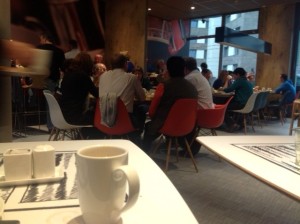Ich werde total müde sein, eine Stunde vor der Sendung von einer 600 Kilometer-Fahrt mit meinem 102-PS-Toyoten in Köln eintreffen, kleine Verhaspeler sind garantiert, spannende Musik auch. Eine Nachtfahrt sozusagen, die in der Normandie beginnt, wo ich ein paar Tage ein wahrlich marodes Schloss bewohnte (als zahlender Gast), das die Gespensterträume meiner Kindheit wachrief. Es gab Ritterrüstungen, Särge, die gesammelten Werke von Alexandre Dumas, Photoverbot, und eine alte Jukebox, bei der ich es mir nicht nehmen liess, immer wieder T.Rex zu drücken.
Nachklang: Samstag, 9 Uhr, Ibis-Hotel, Köln. Eine Viertelstunde unter der Dusche. Die Nachtfahrt, die Sendung, wie in leichter Trance. An der Grenze zwischen Frankreich und Deutschland sang ich im Auto mit Kevin Rowlands um die Wette. Don’t stand me down ist ein genauso vernachlässigter Schatz von Dexys Midnight Runners aus den frühen Achtzigern wie Robert Fripps Let The Power Fall. Auch Jarretts Gitarren-Trommel-Musik leistet wertvolle Dienste auf langen Autofahrten: bei der Musik von NO END erwarte ich jederzeit alte Polizeiautos aus der Bundesrepublik im Rückspiegel und eine Staffel Spürhunde im Anmarsch. Diese Musik kann man „rauchen“, auch wenn Mr. Jarrett stets abstinent lebte. Ganz warm ums Herz wurde es mir später, als ich Asmus Tietchens IN DIE NACHT spielte umd seine Email vorlas. Those were the days. Und die Fremden sind dir plötzlich seltsam nah. We’re all coming from the same tribe. Hey, strahlend blauer Himmel, get it on.

Frühstück im Ibis